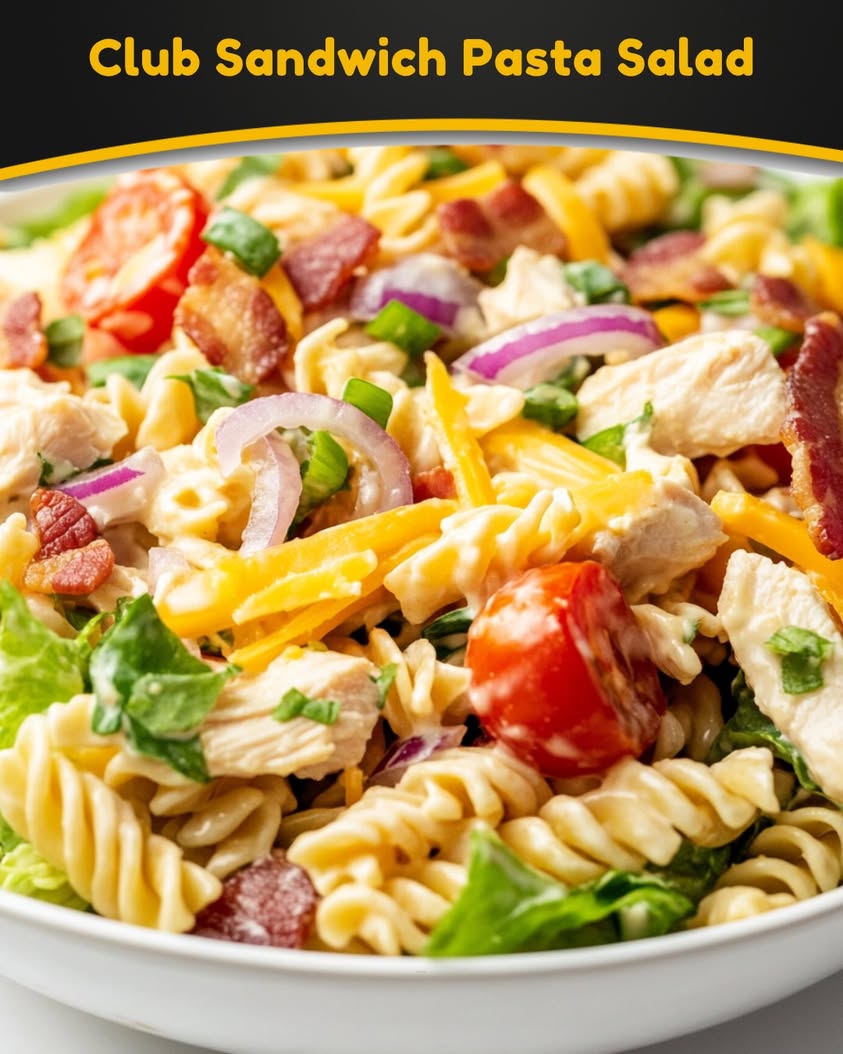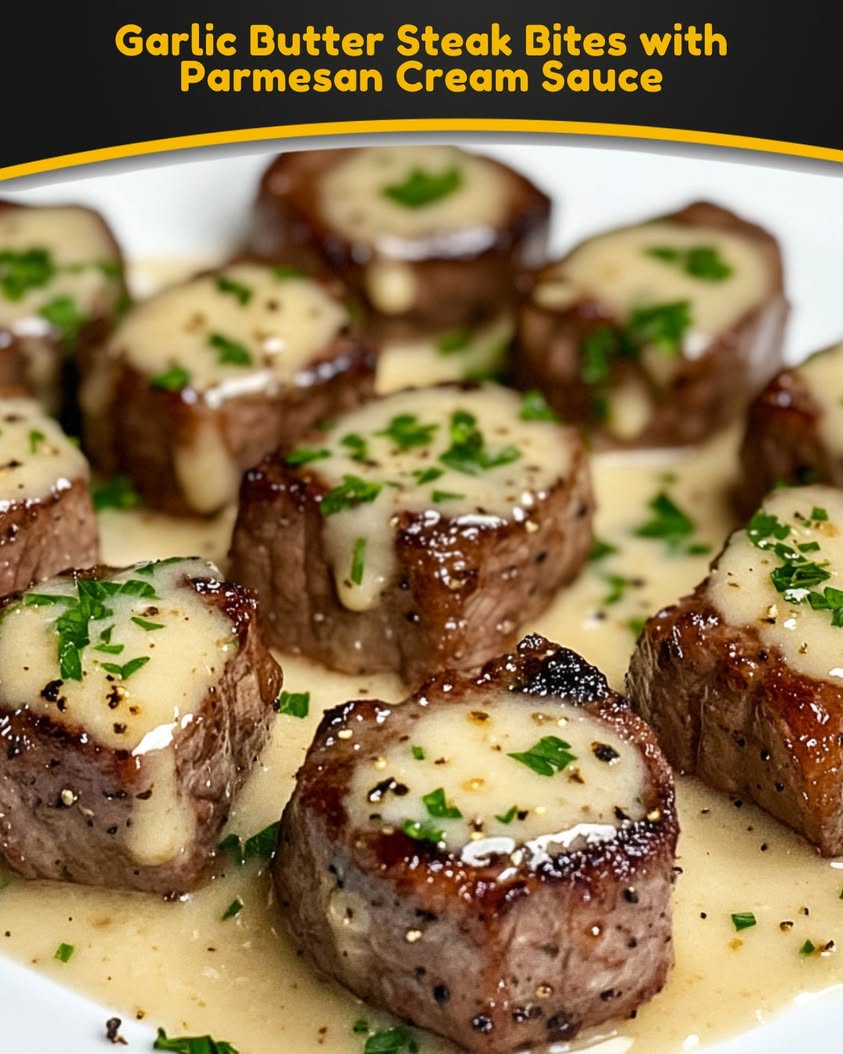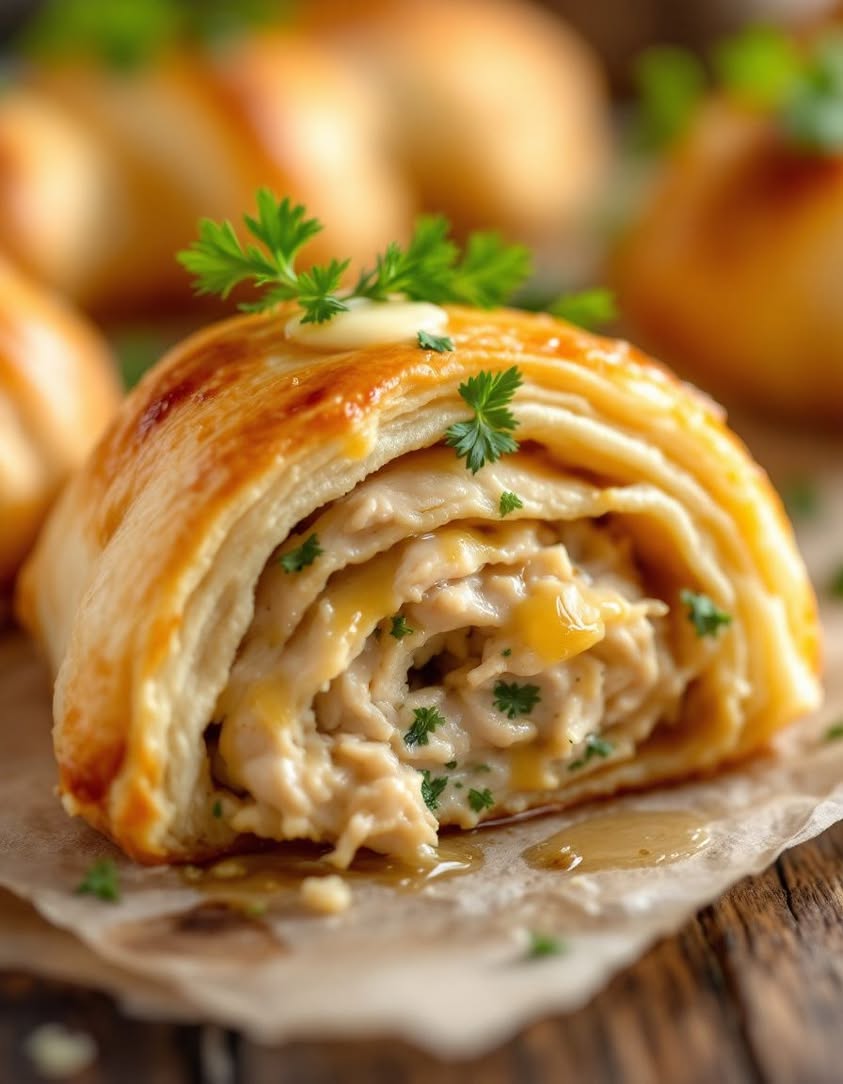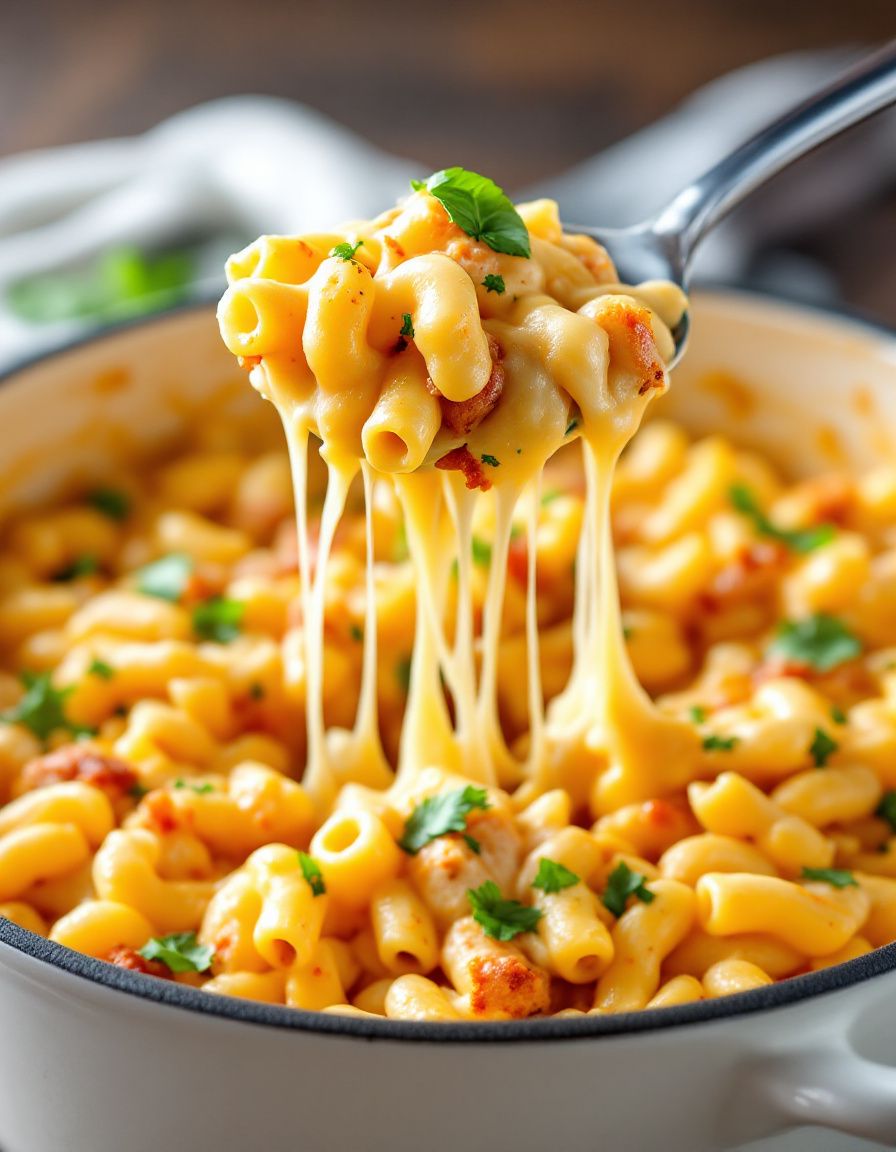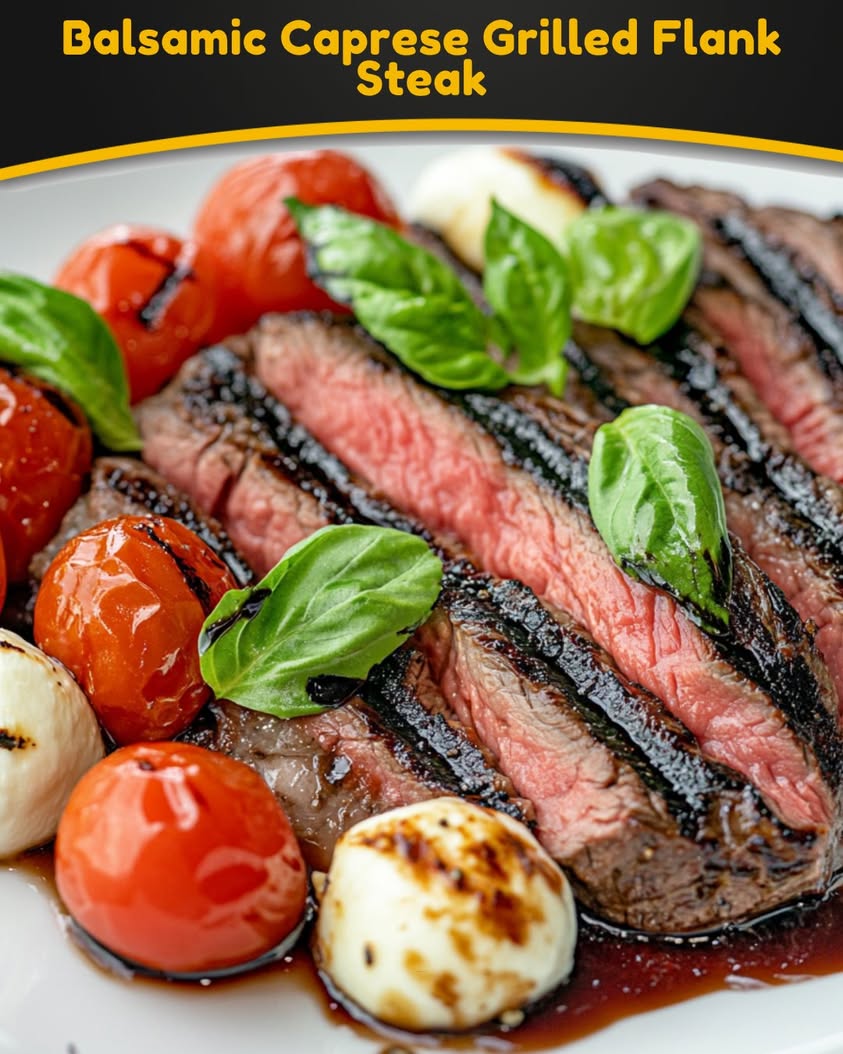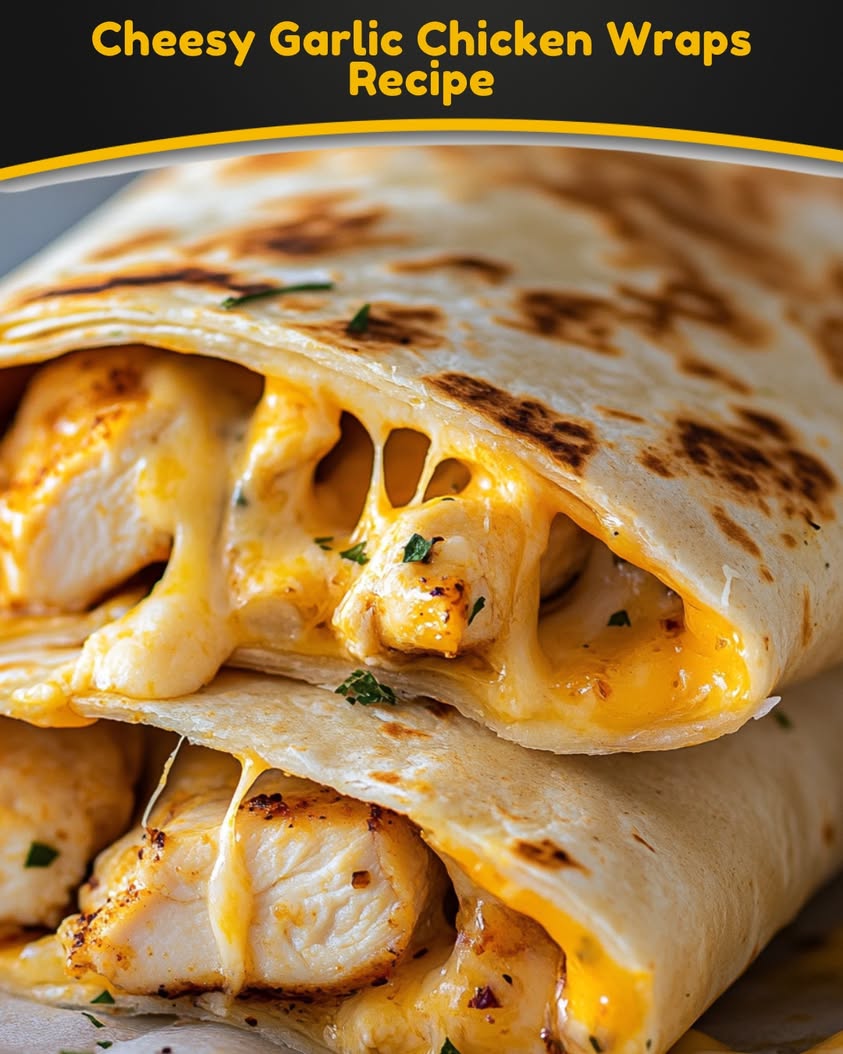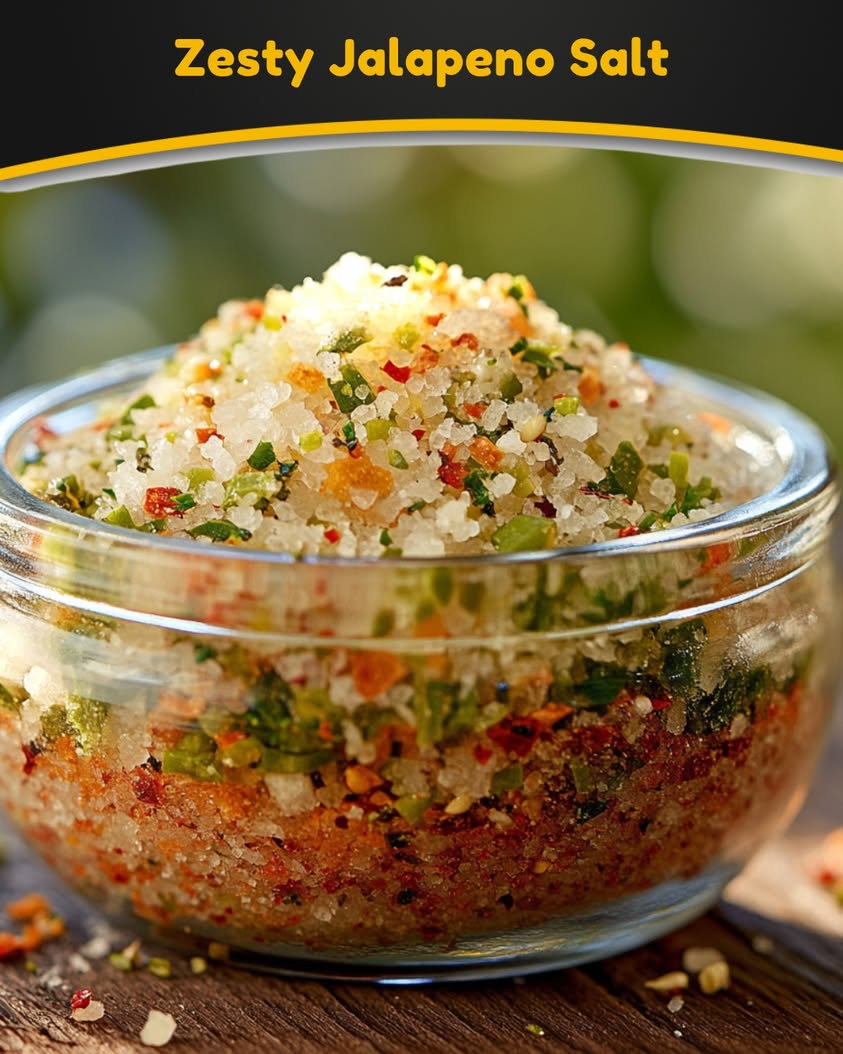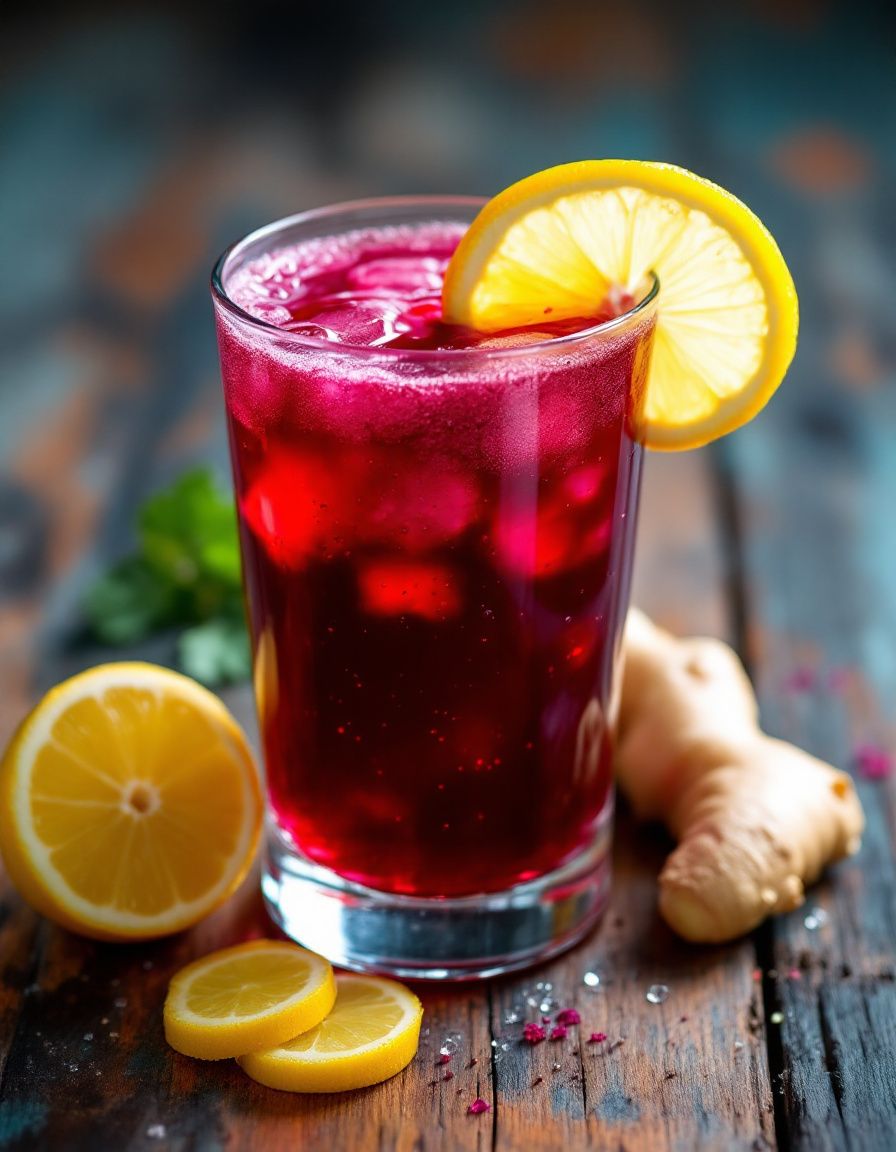Delicious Chicken Stuffed Crescent Rolls: A Flavorful Twist on a Classic
Chicken Stuffed Crescent Rolls combine the tender, juicy flavors of seasoned chicken with the flakiness of buttery crescent rolls, making for a dish that’s not only delicious but also simple to prepare. Imagine pulling a tray of golden, flaky rolls from the oven, their tops sprinkled with a hint of garlic and herbs, revealing a savory filling of shredded chicken, cream cheese, and melted cheese. It’s an indulgent yet comforting meal that can easily become a family favorite, perfect for both casual gatherings and special occasions.
The versatility of Chicken Stuffed Crescent Rolls is another aspect that shines. You can customize the filling with various ingredients like spinach, sun-dried tomatoes, or even different types of cheese, allowing you to cater to your family’s tastes and dietary needs. Plus, with a prep time of just 15 minutes and a cook time of 20 minutes, you can whip up this mouthwatering dish on a busy weeknight without any stress!
Quick Recipe Highlights
- Flavor Profile: These rolls feature a savory filling of tender chicken blended with cream cheese, herbs, and spices, making every bite a scrumptious delight.
- Texture: The outer crescent roll is flaky and buttery, while the inside is creamy and hearty, offering a perfect contrast in every mouthful.
- Aroma: The aroma of freshly baked rolls with hints of garlic and cheese fills your kitchen, inviting everyone to gather around.
- Visual Appeal: Golden brown rolls bursting with filling are visually enticing, making them an eye-catching addition to any table.
- Skill Level Needed: Suitable for cooks of all skill levels, this recipe allows beginners to shine while giving seasoned chefs a chance to experiment.
- Special Equipment: Basic kitchen tools such as a baking sheet and mixing bowl are all you need to create this delightful dish.
Recipe Overview
- Difficulty Level: This recipe is easy to execute, making it ideal for novice cooks. It requires minimal techniques and straightforward instructions.
- Category: Perfect for appetizers, snacks, or a main course, these rolls can fit into any meal or occasion.
- Cuisine: While inspired by American comfort food, these rolls draw influence from various culinary traditions, bringing together a harmonious flavor profile.
- Cost: Typically low-cost ingredients make this recipe budget-friendly, with chicken and crescent rolls being relatively inexpensive.
- Season: Enjoy these rolls year-round; they’re particularly satisfying during chilly months or as a party snack.
- Occasion: Ideal for family dinners, potlucks, or game day gatherings, Chicken Stuffed Crescent Rolls are always a hit!
Why You’ll Love This Recipe
These delectable Chicken Stuffed Crescent Rolls captivate the taste buds with their savory filling and flaky exterior. The mouthwatering blend of shredded chicken, cream cheese, and seasonings creates a rich flavor that pairs seamlessly with the buttery rolls. Every bite offers a delightful experience, making it hard to stop at just one—perfect for satisfying comfort food cravings.
The convenience of this recipe is another major plus. It takes less than 35 minutes from start to finish, making it perfect for weeknight dinners. You can prepare the filling and assemble the rolls in a matter of minutes, which allows you to spend more time enjoying your meal with family and friends. It’s an excellent choice for those busy weeks when every second counts.
From a nutritional perspective, the combination of chicken and cream cheese offers a balance of protein and fats. You can add vegetables to the filling for enhanced nutrition, making these rolls a more wholesome choice. Incorporating spinach or peppers can boost your vegetable intake without sacrificing flavor.
Socially, these rolls create a welcoming atmosphere. Serve them warm out of the oven, and watch as guests gather around, drawn in by the enticing aroma and appealing presentation. Sharing food like Chicken Stuffed Crescent Rolls invites conversation and laughter, making it a perfect dish for entertaining.
Lastly, the cost-effectiveness of this recipe means you can make a large batch without breaking the bank. With simple ingredients and minimal preparation required, you can feed a crowd with ease. Even on a budget, Chicken Stuffed Crescent Rolls are a tasty and rewarding meal option.
Historical Background and Cultural Significance
The origin of stuffed crescent rolls is rooted in various cultures that have long celebrated the combination of bread and savory filling. While the exact history is not documented, variations have sprung up in kitchens around the world. Traditionally, stuffed bread items have served as convenient meals, transporting flavors and nutrients in a portable form, catering to both busy lifestyles and communal gatherings.
In the United States, crescent rolls became popular in the 20th century, often seen as a convenient side at holidays and family dinners. The trend of stuffing them with various ingredients, such as meats and cheeses, has evolved as more families sought quick, satisfying meals. This recipe not only embodies the essence of American comfort food but also highlights the adaptability of crescent rolls to accommodate different global cuisines.
The evolution of this specific recipe showcases how home cooks can personalize their meals to suit their tastes. By incorporating regional flavors or seasonal ingredients, each version can tell its own unique story, reflecting the cook’s background and preferences. This flexibility contributes to the recipe’s increasing popularity.
Finally, regional variations of stuffed bread can often be found, from empanadas in Latin America to calzones in Italy. Each of these dishes borrows the idea of encapsulating flavorful fillings within a tender bread layer, showcasing the global appreciation for this comforting style of cooking.
Ingredient Deep Dive
Chicken
The main ingredient in Chicken Stuffed Crescent Rolls, chicken, is not only a staple in many diets worldwide but also revered for its versatility. This protein source is relatively low in fat, especially when using lean cuts like breast. Chicken contributes high-quality protein, essential for muscle repair and overall health. When selecting chicken, fresh, high-quality breasts or thighs will yield the best flavor and texture, while cooked, shredded chicken saves on prep time. Store any leftover chicken in an airtight container in the refrigerator, and consider utilizing it in other recipes like salads or wraps.
Crescent Rolls
Crescent rolls originated in Austria, where they were first known as kipferl. Over time, they made their way to America, where they became a household favorite, particularly in baked goods and meals. These soft rolls can be enriched with butter for added flavor and moisture. When shopping, look for crescent rolls with few preservatives to ensure freshness. Proper storage in a cool, dry place or in the refrigerator can extend their shelf life. For variations, consider using whole wheat or gluten-free dough alternatives.
Common Mistakes to Avoid
- Overfilling: A common error is adding too much filling, which can cause the rolls to burst open during baking. Aim for a generous but manageable amount of filling.
- Not sealing the edges: Ensure the crescent roll edges are properly sealed to avoid leaking during baking. Pinch the seams tightly for the best results.
- Skipping the pre-heating step: Pre-heating the oven is essential for even cooking and perfect browning. Always make sure to follow this crucial step.
- Using cold filling: If you use cold filling directly from the fridge, it could result in uneven cooking. Allow the filling to come closer to room temperature before assembly.
- Baking on an ungreased sheet: Not greasing your baking pan could result in sticking. Use a non-stick spray or parchment paper to facilitate easy removal.
- Ignoring browning: Keep an eye on the rolls as they bake; opening the oven can cause heat loss, so only check towards the end of the cook time.
- Not letting them cool: Allowing the rolls to cool slightly before serving will help the filling set, preventing spillage on the first bite.
- Rushing assembly: Take your time while filling and rolling them up. A rushed process can lead to untidy or poorly shaped rolls.
- Inaccurate cooking times: Every oven is different, so begin checking for doneness a few minutes before the suggested time, adjusting as necessary.
- Not experimenting: Sticking rigidly to the recipe can limit creativity. Feel free to add your twist with different fillings or seasonings!
Essential Techniques
Sealing the Rolls
Sealing the rolls properly is crucial for retaining the flavorful filling during baking. Start by ensuring that the dough edges are dampened slightly—this will help them stick together as you pinch and roll. Avoid excessive force, which can tear the dough, impacting the overall presentation. Look for a smooth seam once sealed; this visual cue indicates success.
Shredding Chicken
For a tender filling, pre-cooked chicken should be shredded into small, fine pieces. Use two forks to pull the meat apart, ensuring an even distribution of chicken in your filling. Shredding is key, as larger chunks may not mix well and result in uneven bites. Properly shredded chicken also absorbs seasoning better, enhancing flavor.
Pro Tips for Perfect Chicken Stuffed Crescent Rolls
1. Incorporate cream cheese with your filling for extra creaminess and flavor. A brick of cream cheese can elevate the texture and taste.
2. Season the chicken filling well, experimenting with herbs like thyme, basil, or garlic powder to elevate the overall flavor profile.
3. For a golden finish, brush the tops of the rolls with melted butter or an egg wash before baking.
4. Consider adding a sprinkle of everything bagel seasoning before baking for an added crunch and flavor burst.
5. Allow the rolls to cool slightly after baking; this helps the filling firm up, making them easier to serve cleanly.
6. Double the batch and freeze some for later—chicken stuffed crescent rolls freeze well before baking, making for a quick meal on busy days.
7. If using raw chicken, ensure it is fully cooked before shredding to maintain food safety.
8. Experiment with different cheeses, such as mozzarella or pepper jack, for a unique taste experience.
Variations and Adaptations
For unique flavors, consider regional variations such as a Mediterranean version stuffed with feta, olives, and sun-dried tomatoes. Seasonal adaptations might include adding pumpkin puree with spices during fall, creating a cozy, autumn-inspired filling. For dietary restrictions, experiment with dairy-free cream cheese or gluten-free crescent rolls to accommodate various diets while still enjoying this delightful dish.
If you’re looking for a flavor twist, try incorporating BBQ sauce with your chicken for a tangy BBQ Chicken Stuffed Crescent Roll. For texture modifications, increase the crunch by adding toasted almonds or walnuts to the filling. Presentation alternatives can range from rolling the dough into pinwheels instead of traditional shapes to transforming them into mini rolls for bite-sized appetizers.
Serving and Presentation Guide
When serving Chicken Stuffed Crescent Rolls, consider using a rustic wooden board for an inviting presentation. Arrange the rolls in a circular pattern with fresh herbs or salad greens in the center to enhance visual appeal. Garnishing with freshly chopped herbs, like parsley or cilantro, adds color and freshness.
Accompany the rolls with a dipping sauce, such as ranch dressing or a spicy aioli, to elevate the eating experience. Be mindful of temperature; serving them warm maximizes flavor and texture, making each bite even more enjoyable. Additionally, portion control can be managed by cutting the rolls in half before plating, making them perfect for sharing and snacking.
Wine and Beverage Pairing
For wine pairings, consider a glass of Chardonnay, where the creamy notes complement the rich filling of the rolls. Alternatively, a light Pinot Grigio offers a refreshing contrast that enhances the dish’s flavors. If you prefer non-alcoholic options, serve sparkling lemonade or iced tea for a bright, refreshing balance to the savory rolls.
For coffee lovers, a creamy cappuccino could be an intriguing option, merging savory and sweet notes for a unique treat. Be sure to serve all beverages chilled or at room temperature for the best flavor experiences with your Chicken Stuffed Crescent Rolls.
Storage and Shelf Life
When storing leftover Chicken Stuffed Crescent Rolls, place them in an airtight container and refrigerate for up to three days. For longer storage, consider freezing them before baking; wrap each roll individually in plastic wrap and then place them in a freezer-safe bag. They can last up to three months in the freezer.
Signs of spoilage include an off smell or changes in texture, so always check before consuming. Reheat leftovers in the oven at 350°F (175°C) for about 10-15 minutes or until heated through, ensuring they retain their flaky texture. If reheating from frozen, allow extra time to ensure they’re thoroughly warmed.
Make Ahead Strategies
To make Chicken Stuffed Crescent Rolls ahead of time, prepare the filling and refrigerate it in advance. The rolls can be assembled just before baking, saving time during busy meal prep. Alternatively, roll out your crescents, fill them, and freeze them before baking.
For quality assurance, prepare the filling no more than a day ahead. When ready to bake, let them sit at room temperature for a few minutes before popping them in the oven. This allows for even cooking and avoids the dough becoming overly cold.
Scaling Instructions
Scaling the Chicken Stuffed Crescent Rolls recipe is simple. To halve the recipe, reduce the ingredients accordingly, keeping cooking times similar. For doubling or tripling the recipe, consider using a larger baking sheet and adjust baking times slightly, checking for doneness earlier.
If cooking in batches, ensure your oven maintains even heat by rotating the sheets halfway through. Proper storage of any leftovers is essential, as previously discussed, ensuring they maintain quality when stored after scaling.
Nutritional Deep Dive
Chicken offers a fantastic source of protein and essential nutrients. It contains vital amino acids necessary for bodily functions, making it a dietary staple for many. In general, one serving of Chicken Stuffed Crescent Rolls can provide a balanced mix of macronutrients, depending on the fillings and amounts used.
Additionally, crescent rolls introduce carbohydrates that can serve as an energy source. Opting for whole-grain crescent rolls can enhance fiber content, supporting digestive health. Balancing these rolls with salads or vegetables ensures a well-rounded meal, rich in vitamins and minerals.
Dietary Adaptations
For a gluten-free adaptation, use gluten-free crescent dough or an appropriate biscuit dough alternative, allowing those with gluten sensitivities to enjoy this dish. Dairy-free options are also accessible; substitute cream cheese with dairy-free varieties and ensure all cheeses used are lactose-free.
Vegans can create a hearty filling with chickpeas, finely chopped vegetables, and plant-based cream cheese. For low-carb diets, explore using cauliflower dough as a crust to replace traditional crescent rolls. Always tailor your fillings to best suit dietary restrictions while keeping flavors robust.
Troubleshooting Guide
If the texture of your Chicken Stuffed Crescent Rolls turns out soggy, it may involve excess filling. Reduce the amount used or ensure the filling is well-drained before stuffing. If rolls are overcooked, keep a close watch on baking times moving forward, adjusting based on your specific oven’s performance.
For flavor balance issues, experiment with added spices or a touch of acidity, such as vinegar or lemon juice, to brighten up the filling. If you encounter challenges with ingredient substitutions, look for reliable online conversion charts to ensure the best replacements.
Recipe Success Stories
Readers have shared positive feedback about their experiences making Chicken Stuffed Crescent Rolls, noting how simple yet satisfying the recipe is. Many have enjoyed personalizing their rolls with different fillings and spices, claiming it an instant hit at family gatherings.
Some readers also shared tips on photographically capturing the rolls, emphasizing natural lighting and overhead angles for stunning food shots. These inspired stories continue to motivate others to navigate their own culinary journeys with confidence.
Frequently Asked Questions
Can I prepare the filling in advance?
Yes, you can prepare the filling a day ahead. Store it safely in the refrigerator until you are ready to assemble the rolls.
Can I freeze the stuffed rolls before baking?
Absolutely! Assemble the rolls completely, then wrap them well and freeze. When you’re ready to bake, cook them straight from the freezer, increasing the baking time as needed.
What other fillings can I use?
You can experiment with different proteins, vegetables, and cheeses. Try incorporating Italian sausage, spinach, mushrooms, or even pesto for a diverse range of flavors.
What’s the best way to reheat leftovers?
The best way is to preheat your oven to 350°F (175°C) and bake for about 10-15 minutes or until heated through, keeping them crispy.
How do I know when they’re done baking?
The rolls should be golden brown on top and the filling heated through. A toothpick inserted into the center should come out clean without raw filling.
Can I make these rolls ahead of time?
You can prepare and assemble the rolls, then refrigerate them before baking. Bake them just before serving for the best taste and texture.
What can I serve with these rolls?
These rolls pair wonderfully with soups, salads, or dipping sauces like ranch, marinara, or garlic butter for an extra flavor boost.
What is the best way to store leftovers?
Store leftovers in an airtight container in the refrigerator for up to three days. Ensure they cool down before sealing to retain crispiness.
Are Chicken Stuffed Crescent Rolls healthy?
They can be a healthy meal option if you’re mindful of portions and incorporate plenty of veggies in the filling. Opt for whole grain rolls for added nutrients.
Can I use different types of dough?
Certainly! You may use biscuit dough or phyllo pastry as alternatives to crescent rolls, adding different textures and flavors to the dish.
Additional Resources
If you’re interested in other creative uses for crescent rolls, check out our recipes for Chicken Pot Pie Bites or Mini Breakfast Rolls. Understanding baking techniques can also enhance your skills; look for guides on how to properly store dough or manage baking times for different ovens. In addition, exploring other chicken recipes opens the door to numerous meals featuring this versatile ingredient.
Join the Conversation
We’d love to hear your experiences with Chicken Stuffed Crescent Rolls! Share your photos and tips with us on social media or in the comments below. If you have your variations, share them too—community input can inspire new creations and ideas among fellow readers. Don’t forget to rate the recipe, as well; your feedback helps others, and we genuinely appreciate your culinary adventures!
The Recipe
Chicken Stuffed Crescent Rolls
Serves: 8
Prep Time: 15 mins
Cook Time: 20 mins
Total Time: 35 mins
Kitchen Equipment Needed
- Baking sheet
- Mixing bowl
- Measuring cups and spoons
- Cooking spoon or spatula
- Roller (optional)
Ingredients
- 1 package of crescent roll dough (8 ounces)
- 2 cups cooked chicken, shredded
- 1/2 cup cream cheese, softened
- 1/2 cup shredded cheese (cheddar or mozzarella)
- 1 tablespoon garlic powder
- 1 tablespoon fresh herbs (like parsley or thyme)
- Salt and pepper to taste
Directions
- Preheat your oven to 375°F (190°C).
- In a mixing bowl, combine shredded chicken, cream cheese, shredded cheese, garlic powder, herbs, salt, and pepper. Mix until well combined.
- Unroll the crescent dough onto a lightly floured surface and separate it into triangles.
- Place a generous tablespoon of filling at the wide end of each triangle.
- Roll the dough around the filling, starting from the wide end, and pinch to seal the edges.
- Place the rolls on a greased baking sheet, ensuring they are spaced apart.
- Bake for 15-20 minutes or until the rolls are golden brown and the filling is hot.
- Remove from the oven and let cool slightly before serving.
Recipe Notes
- Feel free to substitute different cheeses or add vegetables to the chicken mixture for variety.
- For extra flavor, brush the tops with melted butter or an egg wash before baking.
- You can prepare the filling a day prior to save time on baking day.

